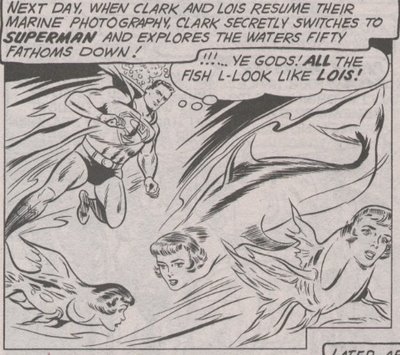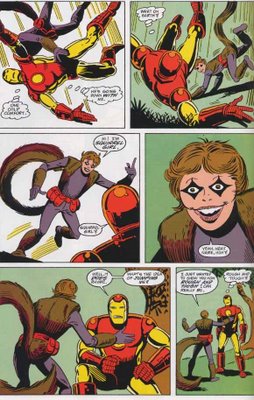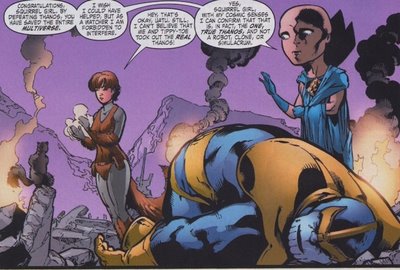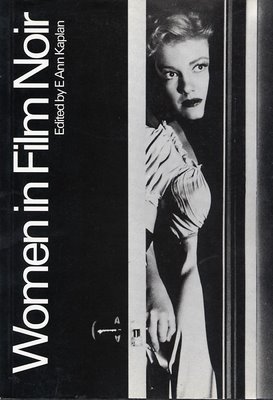Monday, July 31, 2006
Lois' Life Aquatic

I've been making my way through the second volume of the Showcase Superman, which contains stories originally published in 1960-1.
There are some pleasingly strange stories to be found here, and my focus in this post is a particularly striking sequence of images from one titled "The Mermaid From Atlantis." (Superman #138 [1960]; written by Jerry Siegel and pencilled by Wayne Boring.)
In this tale Lori Lemaris, the fetching mermaid whom Superman once loved, is trying to trick the man of steel into proposing to Lois Lane. (Lori has moved on and is married to a merman named Ronal. However, she still cares enough about Superman that she wishes him to experience the kind of wedded bliss she now enjoys).
Part of Lori's plan involves using her mind to push incessant telepathic suggestions at Superman: "She's beautiful ... and so ... helpless! Take Lois into your arms, Superman! And kiss her ... Kiss her now!
When that attempt fails, Lori arranges things so that an unsuspecting Superman will be surrounded by a school of bizarre chimeral fish who have Lois Lane's head superimposed upon their otherwise normal bodies.

Needless to say, this stratagem fails, too.
While all of this is adequatley quirky and strange, what I think is really interesting is that the bizarre face-on-fish imagery might be a visual homage of sorts to George Herriman's Krazy Katfish, his surrealistic aquatic doppelganger to Krazy Kat.
Katfish first showed up in Herriman's Krazy Kat in 1916, and made sporadic appearances thereafter. Since Herriman's comic is absolutely suffused with unrequited passion (Krazy for Ignatz Mouse, and Officer Pup for Krazy), it's not too much of a stretch to imagine an artist visually connecting Lois' own frustrated love to Krazy's.
Here's most of the strip from Sunday, January 30, 1938, one of Krazy Katfish's notable appearances (Krazy and Ignatz, 1937-8, [Fantagraphics, 2006] p. 69):

Friday, July 28, 2006
Feast and Famine
With Birds of Prey #96, Gail Simone delivers another nice issue. Oracle and crew provide a tribute to Ted Kord that was as moving as it was unexpected. And no one writes Black Alice like GS does.
I was especially pleased to see Black Canary honor and re-establish a relationship that had long been missing from her life:

I tried to like Supergirl #8, and I failed. It was just too much work. Poor pacing, an inept conclusion, inconsistent art, and lame exposition all conspired to leave a sour taste in my mouth.
I didn't actually check, but I'm fairly certain that there's no textual reason that can explain the damage to Power Girl's Kandor armor, which creates the familiar peep-hole over her chest. (Man, I'd actually like to read a comic in which Power Girl appears in business attire [or a track suit] for the whole time, I really would.) I know Supergirl blasted an opening into PG's armour several issues ago, but I am sure that PG acquired a new outfit in the interim.

It's been suggested to me that Marvel's crossover is best enjoyed from the sidelines, rather than head on. After reading New Avengers #22, Amazing Spider-Man #534, Civil War: Frontline #4, and Runaways/Young Avengers #1, I whole-heartedly agree.
In his own title, Peter Parker finally shows some welcome thoughtfullness (and respect for Captain America), two things which were missing in his appearance in CW #3.
And in New Avengers, Luke Cage and Jessica Jones mete out a prolonged (and welcome) verbal smackdown to Iron Man and Carol Danvers, making an eloquent case for resisting the registration act. (Jessica has the added advantage of being able to unload her verbal a-bombs while she's cradling her new-born infant.) Later, in conversation with Jessica, Luke utters the crossover's best lines, so far:
So far, the She-Hulk and Ms. Marvel, two heroines I bonded with during my first iteration of comic fandom, have been written onto the wrong side of this conflict. I was relieved to see that over in X-Factor, at least Siryn has got her head on straight. I look forward to learning how Spider-Woman declares her allegiances.
Birds of Prey was a high point this week; a pleasure to read from start to finish. However, I have to admit that after slogging through Supergirl, it was the two pages from The Amazing Spider-Girl appearing in Marvel Previews that actually restored my faith in humanity.
Here's the final page, in which Spider-Girl's startling change of physique and hair color are explained:

I laughed for about an hour when I set eyes on the muscle-bound and bunion-headed Spiderman depicted in the top panel.
I was especially pleased to see Black Canary honor and re-establish a relationship that had long been missing from her life:

I tried to like Supergirl #8, and I failed. It was just too much work. Poor pacing, an inept conclusion, inconsistent art, and lame exposition all conspired to leave a sour taste in my mouth.
I didn't actually check, but I'm fairly certain that there's no textual reason that can explain the damage to Power Girl's Kandor armor, which creates the familiar peep-hole over her chest. (Man, I'd actually like to read a comic in which Power Girl appears in business attire [or a track suit] for the whole time, I really would.) I know Supergirl blasted an opening into PG's armour several issues ago, but I am sure that PG acquired a new outfit in the interim.

It's been suggested to me that Marvel's crossover is best enjoyed from the sidelines, rather than head on. After reading New Avengers #22, Amazing Spider-Man #534, Civil War: Frontline #4, and Runaways/Young Avengers #1, I whole-heartedly agree.
In his own title, Peter Parker finally shows some welcome thoughtfullness (and respect for Captain America), two things which were missing in his appearance in CW #3.
And in New Avengers, Luke Cage and Jessica Jones mete out a prolonged (and welcome) verbal smackdown to Iron Man and Carol Danvers, making an eloquent case for resisting the registration act. (Jessica has the added advantage of being able to unload her verbal a-bombs while she's cradling her new-born infant.) Later, in conversation with Jessica, Luke utters the crossover's best lines, so far:
I ain't going to have my kid grow up to find out that after all we been through, her daddy buckled to the man. ... The people of this neighborhood know me. I want them to see what they do to me for standing up for what I believe is right.
So far, the She-Hulk and Ms. Marvel, two heroines I bonded with during my first iteration of comic fandom, have been written onto the wrong side of this conflict. I was relieved to see that over in X-Factor, at least Siryn has got her head on straight. I look forward to learning how Spider-Woman declares her allegiances.
Birds of Prey was a high point this week; a pleasure to read from start to finish. However, I have to admit that after slogging through Supergirl, it was the two pages from The Amazing Spider-Girl appearing in Marvel Previews that actually restored my faith in humanity.
Here's the final page, in which Spider-Girl's startling change of physique and hair color are explained:

I laughed for about an hour when I set eyes on the muscle-bound and bunion-headed Spiderman depicted in the top panel.
Thursday, July 20, 2006
Catwoman/Squirrel Girl
(Spoilers to Catwoman #57 and Cable and Deadpool #30 follow.)

Here are a few important questions to which we now have definitive answers:
(1) Will Helena's baby-sitter Miranda, introduced in Catwoman #55, turn out to be a psycho-baby-killer?
— No.
(Though, to quote Ricky Ricardo, Selina clearly will have some serious 'splainin' to do.)
(2) Can Selina Kyle beat the crap out of two menacing men while holding her recently-born child (and fighting most of the time with one of Angle Man's razor sharp triangle-doohickies jammed into her heel)?

— Yes.
(3) Can Squirrel Girl kick Deadpool's ass?

— Yes.
(4) Has Squirrel Girl registered under the Superhero Registration Act?
— Yes.
With reference to number (4), I know that Squirrel Girl's actions might make some of you doubt my contention that Squirrel Girl will prove to be the key player on the anti-registration side of Marvel's Civil War.
Though I can understand why some readers might be dubious, I stand firm in my belief and end with a single comment: the ways of the squirrel are subtle and strange.

Here are a few important questions to which we now have definitive answers:
(1) Will Helena's baby-sitter Miranda, introduced in Catwoman #55, turn out to be a psycho-baby-killer?
— No.
(Though, to quote Ricky Ricardo, Selina clearly will have some serious 'splainin' to do.)
(2) Can Selina Kyle beat the crap out of two menacing men while holding her recently-born child (and fighting most of the time with one of Angle Man's razor sharp triangle-doohickies jammed into her heel)?

— Yes.
(3) Can Squirrel Girl kick Deadpool's ass?

— Yes.
(4) Has Squirrel Girl registered under the Superhero Registration Act?
— Yes.
With reference to number (4), I know that Squirrel Girl's actions might make some of you doubt my contention that Squirrel Girl will prove to be the key player on the anti-registration side of Marvel's Civil War.
Though I can understand why some readers might be dubious, I stand firm in my belief and end with a single comment: the ways of the squirrel are subtle and strange.
Tuesday, July 18, 2006
Squirrel Girl at War

Since recently re-reading the "First Kiss" feature in I Heart Marvel: Masked Intentions #1, I've been giving some serious thought to Marvel's Civil War.
And I've concluded that Squirrel Girl is the key to the entire thing. There's no mistaking the fact that she's got independant and deep connections to (not one but) two of the main players at the heart of the event, and I'd bet that, like Kevin Bacon, one we started thinking about it, we'd find even more.
Squirrel Girl carries a major torch for Speedball, the young man whose actions sparked the whole affair. And though her passion for the camera-hungry youth could be discounted as a mere schoolgirl's crush, Squirrel Girl did receive a large measure of reciprocation from Speedball on the final page of "First Kiss."

Call me a starry-eyed fangirl, but I simply cannot imagine that Squirrel Girl is going to allow a de-powered Speedball to rot in some Federal prison on her watch, the punching bag of venal guards and enraged convicts. (And, to add insult to injury, the recipient of relentlessly lame legal advice from Jennifer Walters.) Given these circumstances, inaction on Squirrel Girl's part would be most uncharacteristic. Mark my words, she will act, eager to mete out the necessary payback to those responsible for placing Speedball in his present situation.
In addition, Squirrel Girl has tangled with Iron Man in the past. In introducing herself to Tony Stark as a teen-aged mutant and would-be superhero, she put a small portion of her skills on display.

In that encounter, Stark foolishly spurned her offer to become his partner, though he later accepted her assistance in taking down Dr. Doom.
And though the ways of the squirrel are both subtle and strange, there can be no mistaking that Squirrel Girl gets the job done.

All I can say is: Iron Man, you better be watching your back.
Wednesday, July 12, 2006
Spider-Girl News!

A welcome announcement was posted today at Marvel.com:
The little comic that could has been given a second life as Spider-Girl, which ended at the milestone 100th issue, is now being relaunched as the Amazing Spider-Girl. Thanks to the most dedicated and enthusiastic fanbase in all of comics, the adventures of Mayday Parker will continue in Amazing Spider-Girl #1 with Spider-Girl creator Tom DeFalco still at the healm.
Now that's music to my ears.
From the article by Matt Brady on the reprieve and relaunch at Newsarama.com:
As readers of Spider-Girl #100 are learning today, the last issue of the heroine’s series is just that – only the last issue of that particular series.
As has become the familiar refrain - Spider-Girl lives again - and this time, it’s a little more stable than before.
In October, Marvel will launch The Amazing Spider-Girl #1 by Tom DeFalco, Ron Frenz and Sal Buscema. And – for fans of the character who’ve felt Marvel may have dropped the ball along the line, or never really worked to promote the series, the publisher is rolling out the marketing wagon. Case(s) in point:
— The Spider-Girl Saga #0 which catches readers old and new – up on the character and her world, will come out two weeks before the new #1 issue.
— Ed McGuiness will provide a variant cover for #1.
— Posters featuring the cover to #1 are being readied for promotion.
— The Amazing Spider-Girl postcards are being prepared.
The reprieve is no act of charity; the book's writer Tom DeFalco makes clear that the title has consistently generated income for Marvel. Interestingly, the lion's share of Spider-Girl's sales come from outside of the direct market.
But going back a couple of months ago, they told us that, bottom line, these books are selling terrific in the mass market. We’re reaching an audience that everybody thought and still tend to think that comic books cannot reach anymore. But we’re doing it, and we’re doing it with numbers that are quite significant. That’s why Marvel continues to move ahead with Spider-Girl. Today, when people look at numbers, they tend to look at the Direct Market numbers, and judge form there, but that’s not the whole market anymore – lucky for us.
Monday, July 10, 2006
A Cold Case Re-opened?
What follows is the fifth in my collection of previously posted open questions:

Supergirl #7 opens a narrative door that just might allow for the question to be answered yes.
The image on the issue's final splash page makes it reasonable to assume that Kandor's evil Kal-El is actually the "Superman" who perpetrated the act of which I spoke.
The DC webpage informs us that the next issue will include both the marriage of Supergirl and a battle to the death with Power Girl.
So I carry the following questions to the next installment of Supergirl:
— Do Kryptonians believe in divorce?
— Can Power Girl and Supergirl avoid killing each other?
— Will evil Kal-El get what he so justly deserves?
I hope all three will be answered yes.
In the alternate time-stream depicted in the "Absolute Power" story-line from Superman/Batman, Superman murdered that universe's version of Wonder Woman. Shouldn't he be held accountable for that crime in some way?

Supergirl #7 opens a narrative door that just might allow for the question to be answered yes.
The image on the issue's final splash page makes it reasonable to assume that Kandor's evil Kal-El is actually the "Superman" who perpetrated the act of which I spoke.
The DC webpage informs us that the next issue will include both the marriage of Supergirl and a battle to the death with Power Girl.
So I carry the following questions to the next installment of Supergirl:
— Do Kryptonians believe in divorce?
— Can Power Girl and Supergirl avoid killing each other?
— Will evil Kal-El get what he so justly deserves?
I hope all three will be answered yes.
Saturday, July 08, 2006
Vernacular Architecture
The young people of the Pereira da Silva favela (shantytown) in Rio de Janeiro have built a remarkable miniature favela that they've called Morrinho.

I've always been fascinated by models and simulacra. While at a conference in the Netherlands several years ago, my wife and I made a memorable visit to Madurodam, which we still refer to as that perfect day.
Here's most of the brief text of the article that introduced me to the favela. (Andres Otero, "Rio de Janeiro, Morrinho: Favela Metaforica," Abitare 457 (Jan 2006), pp. 140-145. The photographs were taken in 1997.)


I've always been fascinated by models and simulacra. While at a conference in the Netherlands several years ago, my wife and I made a memorable visit to Madurodam, which we still refer to as that perfect day.
Here's most of the brief text of the article that introduced me to the favela. (Andres Otero, "Rio de Janeiro, Morrinho: Favela Metaforica," Abitare 457 (Jan 2006), pp. 140-145. The photographs were taken in 1997.)
Morrinho reproduces the world [the young people] live in. Their models are the chaotic buildings in the favelas, its dead-end roads and impossibly steep stairways, not the luxury apartment blocks of the 'asphalt' or the sea-front avenues. Pretty soon a whole town takes shape, complete with bus-stops, neighborhood associations, churches, bars, police stations, motobike taxi ranks and drug-traffic stake-outs. A favela within a favela. Everywhere there are small notices: "They betrayed me while I was alive and forgot me when I was in jail; you'll miss me when I'm dead, the saudade"; "Let he who is without sin cast the first stone or fire the first shot. Signed: PCC, CVF, mafia"; "I'm afraid Christ is passing us by and won't come back" ... The kids use the models to play at "cops and traffickers", staging shootouts, high speed reversing and road blocks. "Normal" life, but on a smaller scale. Paradoxically, their minutely detailed rendering of hard reality helps keep them away from real violence and drug trafficking. Some of them win a dregree of fame. The luckier ones manage to get a job in video and concert production, to find a way forward ...Four of the creators: Nelciran, Rodrigo, José Carlos and Vinicius.

Friday, July 07, 2006
Godard Proven Right
All you need to make a film [or comic] is a girl and a gun.--Jean-Luc Godard.

It was a pleasure to see how Ted Naifeh manoevered Polly Pringle out of a spot of trouble in issue #6 of his wonderful Polly and the Pirates. Now that I've had the opportunity to re-read all of the issues as a completed series, I can't praise or recommend it highly enough.
Though the issue brings Polly's adventures to a close, I was heartened to read several bits of dialogue here and there that could be interpreted as allusions to possible future activities.
As a satisfied reader, I heartily second Scrimshaw's sentiments:

Tuesday, July 04, 2006
Independence Day, 2006

John J. Barralet, Apotheosis of George Washington, 1802.
(Lithograph, the Maine Historical Society.)
Following Washington's death in 1799, many paintings, drawings, and lithographs on the theme of his ascension to paradise were produced. These images are fascinating visual evidence that the revolutionary era was both modern and early modern at the same time.
Rather than take the opportunity to denounce George III and Lord Bute, I'd rather allow a nineteenth-century observer to describe one of the ancillary expressions of independence he discerned in early America.
I was recently re-reading Alexis de Tocqueville's Democracy in America (1835), and was especially struck by chapter 12 of Part III, titled "How the Americans Understand the Equality of Man and Woman." (Pages 705-8 in the Library of America edition, edited by Arthur Goldhammer.)
Now, there's no doubt that this chapter was written by a nineteenth-century European man whose aim was to juxtapose American virtue to European vice. However, though idealized, his interpretation is pretty nuanced nonetheless. (For example, he doesn't argue that there is full equality of the sexes in America.)
Here are several excerpts:
American men consistently demonstrate full confidence in the reasoning abilities of their helpmates and deep respect for their freedom. They deem a woman's mind as capable of discovering the naked truth as a man's and her heart as stalwart in adhering to it, and they have never sought to protect her virtue any more than his behind a shelter of prejudice, ignorance, and fear.
In Europe, where men so readily submit to the despotic sway of women, they nevertheless seem to deny them some of the principle attributes of humankind and look upon them as seductive but incomplete beings. What is most surprising is that European women ultimately come to see themsleves in the same light and are not far from considering it a privilege that they are allowed to seem frivolous, weak, and fearful. American women insist on no such rights. (707)
Thus, Americans do not believe that man and woman have the duty and right to do the same things, but they hold both in the same esteem and regard them as beings of equal value but different destinies. Although they do not ascribe the same form or use to a woman's courage as to a man's, they never doubt her courage; and while they hold that a man and his helpmate should not always use their intelligence and their reason in the same way, at least they believe that a woman's reason is as secure as a man's and her intelligence just as clear.
Americans have thus allowed woman's social inferiority to persist but have done all they could to raise her intellectual and moral level to parity with man, and in this respect they seem to have shown an admirable grasp of the true notion of democratic progress.
... [I]f someone were to ask me what I think is primarily responsible for the singular prosperity and growing power of this people, I would answer that it is the superiority of their women. (708)
If read carefully, Tocqueville's chapter on women serves two purposes: it expertly describes the liberating and pernicious effects of the ideology of separate spheres, while also pointing to how equality of education contains the seeds of enhanced liberation for America's women.
Sunday, July 02, 2006
Noir Women

The August issue of Wizard magazine has a nice little sidebar (p. 131) on X-Factor, a recently relaunched title that I'm actually enjoying quite a bit. The piece, titled "The Noir 'Factor'," has been prompted by Marvel's impending release of a hardcover premier edition containing issues 1-6.
The sidebar lists 5 noir factors that make X-Factor worth reading, the first being Femmes Fatales.
Unfortunately, they totally misuse the term.
Here's what they say:
The series packs four of the baddest broads into one title: Wolfsbane's the moral center and bloodthirsty enforcer; Siryn and Monet combine for a one-two punch of sex appeal and attitude; and Layla with her chaos theory powers provides the unknown element of surprise.
Now, there is indeed an enduring archetype derived from film noir that we call the femme fatale. However, the central thing that separates these women from the heroines of X-Factor is that association with noir femmes fatales was often, well, fatal.
And while I grant you that Siryn, Monet, and Wolfsbane are indeed depicted as sexy women, (with each exuding their sex-itude in a different way), here's the key distinction:
While femmes fatales are, by definition, sexy, not every sexy woman in a noir film or publication is a femme fatale. Sexiness is not the key characteristic of the femme fatal; ruthlessness and single-minded murderousness are.
My point, just for clarity: in noir, beautiful women need not be fatal, guys.
In the great noir films of the forties, the femmes fatales were conniving women who sported killer hair nets, proudly balanced jewel-studded turbans atop their heads, and walked over men in their seriously un-sensible shoes. They used their edgy sexual appeal to ensnare unsuspecting (previously "good") men, and enlisted them as cogs, patsies, and enforcers in their convoluted murderous schemes. Most importantly, these "spider women" fully intended to dispose of the fellows who had wandered into their webs once they outlived their usefullness.
To make things crystal clear to viewers, creators of noir films often juxtaposed a wholesome "good girl" to the femme fatale. And just to make things easy, the femme fatale was often dark haired, with "the good girl" being a blonde.
Notable femmes fatales:
— Barbara Stanwyck in Double Indemnity, 1944.
— Ann Savage in Detour, 1945.
— Jane Greer in Out of the Past, 1947.
Now, there's a nice moment in X-Factor #8 in which Siryn uses her you-will-love-me voice in order to gather some crucial information from an unsuspecting (Spider)man.

Is Siryn duplicitous, here? Yes.
Is this power likely to produce disastrous after-effects? It already has.
Does Siryn wield this power in the furtherance of a murderous scheme for personal gain, with the intention of ultimately causing the death of the person she's speaking to? Of course not.
Siryn is a superhero, she's not a femme fatale.
